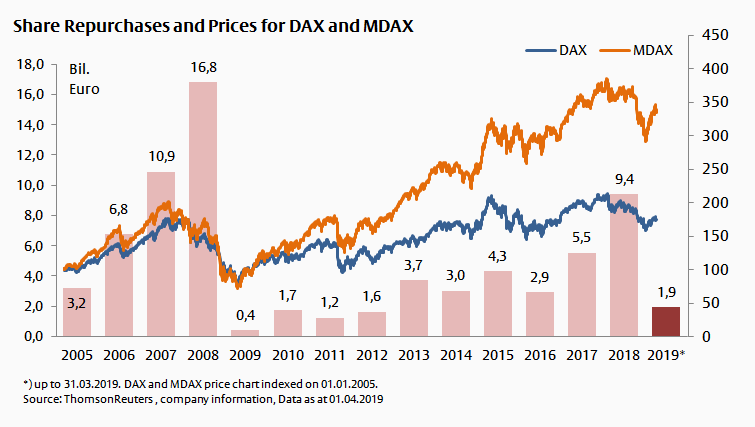08.04.2019 - Comments
![[Translate to English:]](https://www.flossbachvonstorch-researchinstitute.com//fileadmin/_processed_/5/b/csm_kommentar-philipp-immenkoetter-klein_33283eeca4.jpg)
Ten DAX and MDAX companies have already repurchased their own shares this year and four more consider doing so. Whether this is good or bad for shareholders depends, among other things, on their timing.
The price at which a company acquires its own shares is decisive. Buybacks are usually carried out when cash holdings are high and business is going well. However, this is usually accompanied by high share prices, which make buybacks expensive. If, on the other hand, share prices are low, companies usually lack the funds to buy their own shares. Thus, in times of high liquidity, companies face the dilemma of either buying their own shares at high prices or investing the free funds in unprofitable alternatives.
The graph illustrates the situation. Times of high prices, such as 2007/2008, 2015 and 2017/2018, coincide with high buyback volumes. After price drops, on the other hand, buybacks volumes decline. This can be clearly seen in 2009 and 2016.

German companies seem to want to solve the dilemma through procyclical share buybacks. Only Munich Re has managed to extend share buybacks over a longer period and has bought its own shares in 11 of the last 14 years.
The ten currently active repurchasers include familiar names such as Adidas and Linde, who already carried out repurchases last year. On the other hand, new players such as Fresenius Medical Care, Lanxess and Osram Licht are also among them. If the announced volumes were realized in 2019, the level at the end of the year would be similar to that at the end of 2018.
Despite the recent profit warnings and forecast adjustments, share prices seem to have recovered, so that it is to be expected that the outstanding buybacks will again be carried out at record prices. Thereby it would be possible to escape the dilemma: For example, with a special dividend. Although it is not as flexible as buying back shares, it circumvents the problem that capital distribution depends on the share price and funds vanish if prices fall subsequently.
